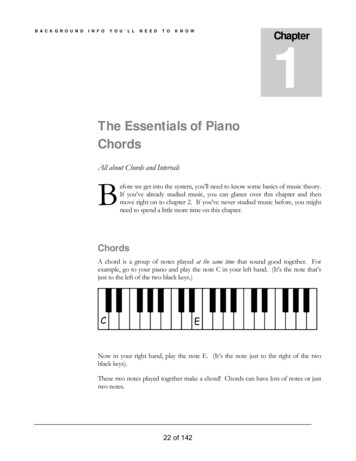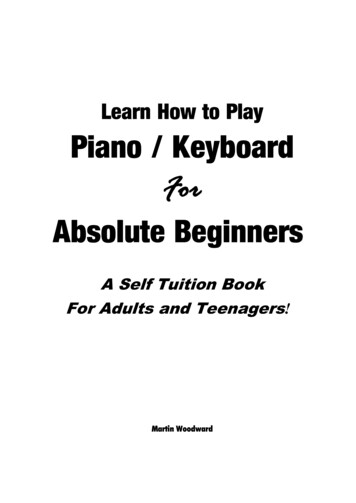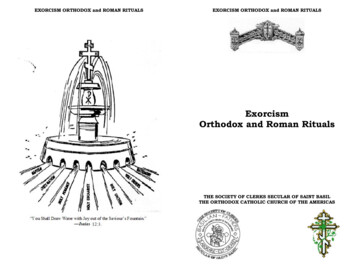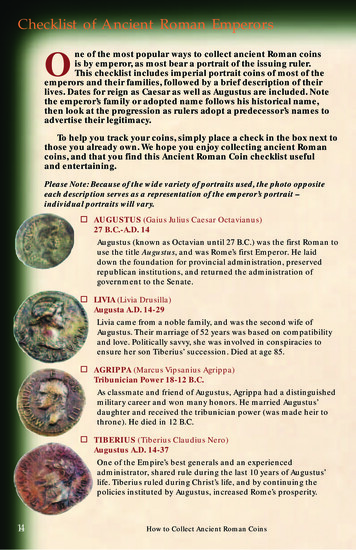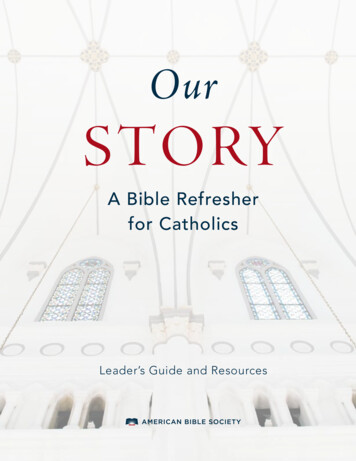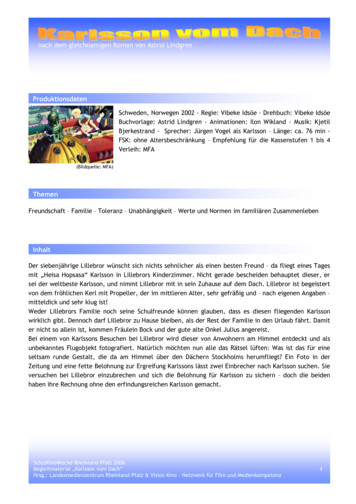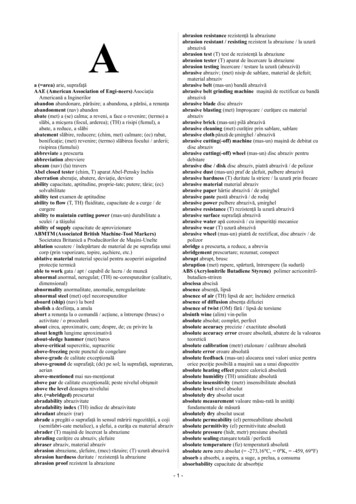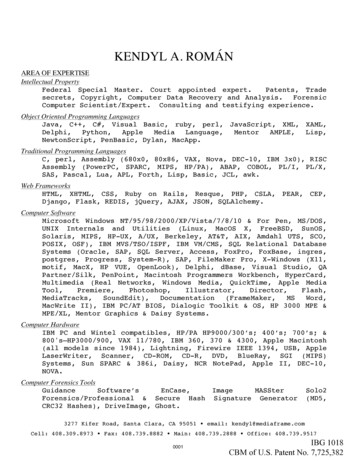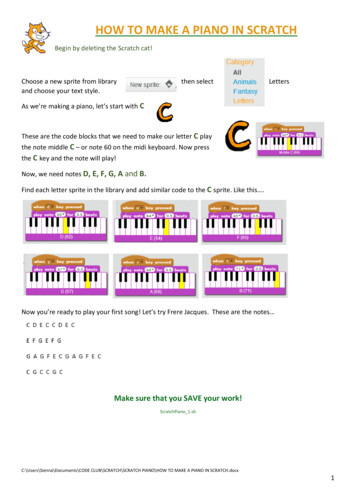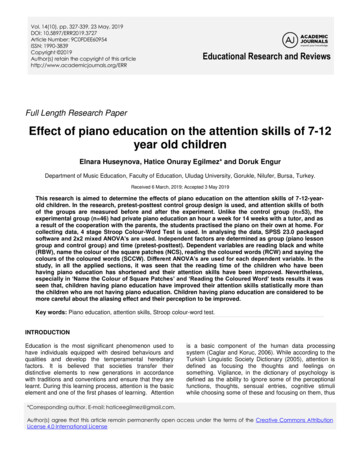![Roman Statkowski [1859-1925] Piano Music](/img/3/25129booklet.jpg)
Transcription
Roman Statkowski [1859-1925]1Toccata, Op. 33Piano Music3:43Preludes, Op. 372No. 1 in C major3No. 2 in A minor4No. 3 in G major5No. 4 in E minor6No. 5 in D major7No. 6 in B minor1:550:581:561:373:223:19Mazurkas, Op. 248No. 1 in E minor9No. 2 in F minor10No. 3 in A minor11No. 4 in G flat major2:593:542:293:16Immortelles, Op. 1912B major13C major14F sharp minor15E flat major16E flat minor17A flat major3:542:561:111:231:542:35Six pièces, Op. 1618No. 1 Capriccio19No. 2 Impromptu20No. 3 Valse21No. 4 All’antico22No. 5 Alla burla23No. 6 Aupres de la fontaine4:114:414:422:573:402:55total duration:Barbara Karaśkiewicz piano66:36
The Composer and his MusicRoman Statkowski was born on 24 December 1859 in Szczypiorno, near Kalisz in Poland, intoa family of landowners with a passion for the arts. His early fondness for music was likely nurturedwithin his own very musical family where he grew up in the tradition of the music salon. Roman’smaternal aunt, Stefania Wilska, was a talented pianist of high musical sensibility. His first musicteachers were the established Polish musicians Antoni Sygietyński and Władysław Żeleński. Hiscompositional tuition was undertaken at the St. Petersburg Conservatory between 1886 and 1890under Russian composers Nicolai Soloviev and Anton Rubinstein, whose guidance must surelyhave contributed to a level of artistry at piano playing which Statkowski would later bring to hisown composition. In the field of instrumentation Statkowski studied under the great NicolaiRimsky-Korsakov. Having graduated from the conservatory in 1890 having earned his diploma anda gold medal, Statkowski settled into work as a teacher in a music school in Kiev.Over the next few years he would live in his family’s estate in Volyn, moving from there to Berlinand then in 1898 he arrived in Moscow to begin managing the local branch of the Herman& Grossman Warsaw piano store. In 1901 he returned to St. Petersburg, continuing to work forthe piano storehouse until 1903 when the loss of his job gave rise to a move to Warsaw. In thenext year he began working at the Warsaw Music Conservatory, teaching history of music,aesthetics, diction and composition.Although Statkowski did not delight in his role as pedagogue, the work absorbed him totally. Heapplied all of his knowledge and time to the work – and to excellent effect. Many of his studentswould become significant personalities in the world of music in Poland. He earned their trust andhigh regard through his attitudes of tolerance in compositional experimentation, his opennessto discussion with them and in his refusal to accept obvious or easy solutions.Statkowski was aware of the myriad innovative directions which were possible in music, though histaste was for the style of the late Romantic era. As a composer, his priority was in exposing themelodic line and the traditional craft, rather than a constant striving to innovate. He cultivated onlythe well known and proven musical forms of opera, quartet, and instrumental miniatures. Todaywe can but speculate on what might have been Statkowski’s legacy had he not replacedcomposition with teaching. From 1904 until his death in 1925 he did not compose a single pieceof music. Of the work he produced, the majority is designated for piano: 55 Miniatures have been
preserved and published, but Statkowski also composed two operas (“Filenis” and “Maria”), sixstring quartets and four cycles of miniatures for violin and piano.In historic memoirs, descriptions of Statkowski’s character are more suggestive of that of a lawyeror a banker than the more traditional stereotype of absent-minded, soulful musician – he wasconsidered an elegant gentleman with impeccable manners, imbued with a dignified demeanour anda highly respectful attitude towards people.Toccata, Op. 33In terms of virtuosity, this is perhaps the most impressive piano piece by Statkowski. The hugecondensation of technical difficulties, a dense texture using chords and arpeggios as well asa powerful expressionist content distinguish this miniature from the others. The homogeneousdemiquaver accompaniment in the left hand is extremely demanding for the pianist because of thelarge distances between the particular sounds of the broken chords and the high tempo involved.The right hand performs the melody in octaves and chords.Six préludes, Op. 37This cycle consists of six miniatures contrasting with each in terms of their texture and character.The wide array of tone colours, moods and technical measures as well as the perfect constructionand the brevity of the form make the Préludes an attractive proposition for the concert pianist andalso as valuable teaching material.Prélude No. 1, in C major, is imbued with a poetic, reflective mood. Thanks to its harmony,it brings to mind the musical language of Impressionism. Prélude No. 2, in A minor has, in contrast, aturbulent, restless nature. The fourth Prélude, in G major, is melodious and cheerful. The followingpiece in E minor has resonances with the famous Prelude in C sharp minor (Op. 3 no. 2) byRachmaninov. We can almost hear the sound of bells. Prélude No. 5, serene in its song-like lyricism,provides some ease before the final Prélude in B minor. This miniature is based on triplet figurationsperformed by the left hand, supporting both rhythmically and harmonically the nostalgic melody ledin crotchets (quarter notes) and minims (half notes) by the right hand. Consistently appliedmordents on the second measure of each bar in the left hand’s uniform accompaniment require ahigh level of precision from the performer.
Mazurkas, Op. 24The obvious archetypes for the mazurka itself are those composed by Chopin. Statkowski, whowas born ten years after Chopin’s death, moved the mazurka to a new dimension. Although manycomposers had imitated Chopin’s style in mazurka, Statkowski’s approach is very creative andfresh. The innovations include polyrhythmics, polymetrics and hemiolas which distort the typicalmetrorhythmics of the mazurka. The inspiration of half of the piano pieces by Statkowski wasPolish folk music. These are still rooted in the convention of Polish traditional dances but at thesame time they are enriched by various virtuoso treatments. Their skilful stylisation makes thema valuable contribution to the pianistic repertoire.Immortelles, Op. 19The title “immortelle” means “everlasting” and may relate to the name of the flower(Xerochrysum family), from which Everlasting Oil is prepared. The pieces recorded here are onlypart of the whole set of Immortelles. I could only find the scores of those presented on this album.Unfortunately many of Statkowski’s manuscripts had been burned during World War II in Warsaw,some of which were to be published as Preludes. These graceful and diversified miniatures ofan uncomplicated structure may be considered as a compositional exercise preliminary to the cycleof Preludes Op. 37, which in my opinion is much more mature. Nevertheless, even regarded as lesmature compositions, they are a delight to the ear.Six pièces, Op. 16This is the largest cycle amongst Statkowski’s piano compositions. It consists of six pieces,demanding from the pianist a great variety of pianistic and expressive techniques. Capriccio isof exuberant nature, full of shine and grace. We may easily find here some associations withChopin’s music. This is the most complicated work in the cycle, in terms of the density of technicalmeasures. We can find many figurations, chords and octaves here. Impromptu is the mostconventional piece within Opus 16 in terms of harmony, but at the same time it gives somepleasant respite before the Waltz, which is the longest of the Pièces. Valse is a brilliant, gracefulrondo; like Capriccio it is very demanding to the artist. All’antico moves us back to the times of thegreat French harpsichordists. It is a subtle stylisation, of a type found in similar works by Kreislerand Paderewski.
The following Alla burla, with its dashing brio and vital energy provides a strong contrast to theplayful elegance of All’antico and also to the final piece of the cycle, Auprès de la fontaine. This isa brilliant conclusion, created in the spirit of impressionism. By its illustrative title and the lambencyin both its melodic and tonal coloration, the miniature is reminiscent of water’s fluidity.The limited size of these compositions, their poetics and intimacy were particularly valuablefor Statkowski. Therefore he eagerly wrote small pieces, the content of which is extremelycondensed. The miniatures were combined predominantly in cycles consisting of between two andsix pieces. The cycles are varied and colourful thanks to their dramatic structure, which is builton the principle of the emphatic contrasts between particular works. Most of the piano works byStatkowski are based on the three-part reprise form, characteristic of romantic vocal andinstrumental lyrical pieces. The construction of Statkowski’s piano works is very well nuanced,disciplined and compact. Each of the miniatures is multisectional and built with the principle ofsymmetry. The most frequent technique in which he develops the form is that of figuration; thetexture is diversified and changeable within the piece. Noticeable also is the balanced writing andco-ordination for both hands, by frequent activation of the left hand.The melodic line is always in the foreground. It is a structural factor of Statkowski’s formaldevelopment (development of the musical form). Every element is subordinated to the prioritygiven to the melodic line, which results in the exposure of its aesthetic values. The musicalstructure is shaped in a vocalistic manner which reminds one of Mendelssohn’s Songs WithoutWords. The melody is full of lyricism, emotionally saturated and varied with rich ornamentationusing trills, mordents and arpeggios.In the area of harmony, Statkowski’s compositions remain in the Romantic trend, being absolutelytonal. They are faithful to the 19th century’s convention of major-minor keys, using modulations,progressions, pauses, interjectional parenthetic chords and chromatics. The rhythmic structureis especially important in the pieces deriving from the background of folk music. In the non-folkpieces the composer uses a single rhythmical structure over the whole piece, thereby obtaining theeffect of fluency and smoothness.The tone colour is very much diversified by using different compositional methods. In Statkowski’spiano pieces the action takes place in every register of the piano. Also, the technical variation andthe diversity of articulation which the composer applies result in a high level of variation of tone.In terms of tempo we may observe a high degree of changeability of tempos within the pieces. The
dynamics in the music are much dependent on other musical factors. The changes in the soundlevel are very frequent and marked, and they often influence the entire expression of the work.The expressive aspects of these compositions include for example the nuances of dynamics andcoloration, the contrasts between themes and – last but not least – the sophistication of the pianotechniques. Among these we may point inter alia: intricate fingering technique, double thirds,broken chords, passages of chords, octaves, figurations, and polyphonic elements. The chords andfigurations are full of invention and demonstrate the composer’s great knowledge of the piano’srange of sonorities.Powerful contrasts between themes, diversity of textures and variability of expression are the chieffeatures of this music, but which lead to the intended result of a final simplicity and sincerity.In the context of the period, Statkowski’s compositions might be classified as neo-romantic. Thestylistics and the compositional techniques are characterized by a skillful assimilation of the mainfeatures of European romanticism in music.The piano works presented here are sophisticated, full of invention and perfectly composed.This oeuvre is an important contribution to the Polish and European piano repertoire of the late19th and early 20th century, and fully deserves to be appreciated by a much wider audience than hasbeen the case until now. 2015 Barbara KaraśkiewiczMusic publishers (original):Toccata: Polskie Wydawnictwo Muzyczne, KrakowSix Préludes: Gebethner i Wolff, WarszawaMazurkas: Ries und Erler, BerlinImmortelles (tracks 12-14): Echo Muzyczne, Teatralne i Artystyczne, 1895 No. 2 Supplement(tracks 15-17): Willcocks & Co, LondonSix pieces: Ries und Erler, BerlinRecorded in 2012 Sound engineer: Piotr Czerny (Fisdur Rec)Piano: FazioliBooklet and packaging design by Stephen Sutton (Divine Art)Cover photo and page 15 photo of Barbara Karaśkiewicz: Paweł SzczepanikAll images are copyright – all rights reserved 2015 Divine Art Limited (Diversions LLC in USA/Canada)
Kompozytor i jego muzykaRoman Statkowski urodził się 24 grudnia 1859 rokuw Szczypiornie koło Kalisza (dzisiejszy Kalisz).Pochodził z rodziny ziemiańskiej o artystycznychzamiłowaniach. Wyrastał w tradycji salonumuzycznego schyłku XIX wieku. Z domu zapewnewyniósł zamiłowanie do muzyki. Siostra jego matki,Stefania Wilska, była utalentowaną pianistką,odznaczającą się wysoką kulturą muzyczną.Pierwszymi nauczycielami Statkowskiego byli znanimuzycy polscy: Antoni Sygietyński i WładysławŻeleński. Ostatnie muzyczne szlify Statkowskiotrzymał w Konserwatorium Petersburskimw latach 1886-1890, w klasie kompozycji MikołajaSołowiowa i w klasie fortepianu AntoniegoRubinsteina, ówczesnego dyrektora tejże uczelni.Pod kierunkiem tego ostatniego prawdopodobnie uzyskał wysokie umiejętności pianistyczne,wykorzystywane później przy komponowaniu własnych utworów. Instrumentacji uczył sięu słynnego Mikołaja Rimskiego – Korsakowa. W roku 1890 Statkowski ukończyłKonserwatorium, otrzymując dyplom i złoty medal.Po studiach Statkowski zamieszkał w Kijowie, gdzie pracował jako pedagog w szkolemuzycznej. Później przebywał w swoim majątku rodzinnym na Wo
Having graduated from the conservatory in 1890 having earned his diploma and a gold medal, Statkowski settled into work as a teacher in amusic school in Kiev. Over the next few years he would live in his family’s estate in Volyn, moving from there to Berlin and then in 1898 he arrived in Moscow to begin managing the local branch of the Herman & Grossman Warsaw piano store. In 1901 he .

